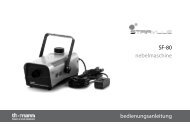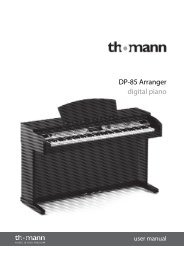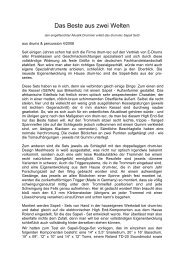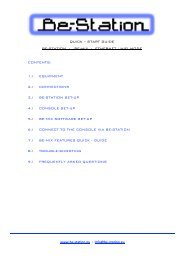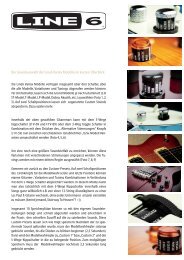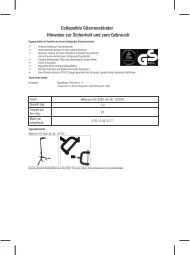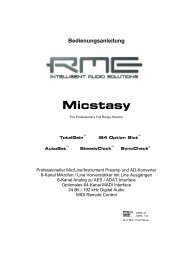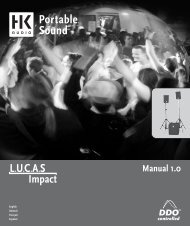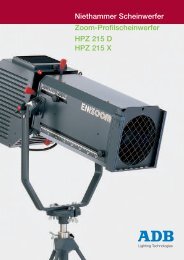Create successful ePaper yourself
Turn your PDF publications into a flip-book with our unique Google optimized e-Paper software.
Dynamics<br />
While compression can tame hats and balance the levels of different hihat articulations, remember that it’s always nice to retain<br />
a good amount of dynamics for the hihat, as this can contribute a lot to the feel of a groove. Therefore, try not to over-compress<br />
hihat channels. You can, of course, adjust the levels of individual hihat articulations in the kit-piece inspector, something which is<br />
sometimes vital as EQ-ing in particular can pronounce the energy of non-closed articulations.<br />
Toms<br />
EQ<br />
The bass energy of toms tend to lie in the 50-120 Hz range. Obviously, larger toms have much more bass energy than smaller<br />
ones.<br />
The main body of the toms, in the 120-500 Hz range, can be very troublesome - there is a danger of them ending up sounding<br />
too thick and heavy. Some good use of a narrow-bandwidth EQ cut (tuned to taste) helps the toms to sit in the mix better without<br />
overpowering everything else.<br />
The attack of the toms lies in the 1-7 kHz range - this contains ‘the bite’ of the tom. If you remove a lot of mid-range, then you’ll be<br />
left with this frequency range, with the toms having very little apperent sustain.<br />
Tom selection<br />
If you want thunderous toms, use larger ones! Don’t stick to preset conventions on tom selection. BFD2 allows you to mix and<br />
match toms, so you can assemble custom tom sets. Two floor toms and a rack tom can be great, even if the 2 floor toms are not<br />
from the same set - once they are EQ’d and compressed in the mix it is very hard to tell that they’re from different kits. Replacing<br />
the high tom with a mid tom is often a good idea, as many high toms are too small (and therefore high-pitched) for some applications.<br />
Damping<br />
Using BFD2’s damping controls on toms is a great alternative to using gates to ‘tame’ the toms. Most of BFD2’s toms are recorded<br />
undamped to allow maximum flexibility. For certain types of music, they can last too long in their untreated form. Use large<br />
amounts of damping (over 50%) for funk and other groove-based music, where an excessively resonant set of toms would take<br />
over the mix. The same applies to metal, where the beats are just too dense to accomodate undamped toms.<br />
Panning<br />
Try not to heavily pan the toms – there aren’t many drummers with arms 12 feet across. Also, toms with lots of low-end (such as<br />
floor and large mid toms) usually sound better when mixed in both speakers.<br />
Cymbals<br />
EQ<br />
Like the hats, it’s very useful to high pass filter the cymbals heavily. Again, it gets rid of ‘gongy’ tones and low-end ‘bark’.<br />
Don’t be afraid to cut too heavily, even all the way up to 2 kHz or more - this is a very common technique in the context of modern<br />
rock or pop production.<br />
Take care when boosting treble on cymbals, as it very easy to overdo it and up with an cymbal track that is too bright and messy.<br />
Mic channels<br />
It can be good to use more ambience than direct signal with cymbals. Using the overheads makes cymbals sit in the mix more<br />
realistically. However, try and retain a good amount of the direct channel for rides, as this helps the attack to cut through.<br />
General guidelines for EQ and compression<br />
Remember to read the ‘Approaching EQ and compression’ topic in section 12:1. This contains some important general guidelines<br />
when using EQ and compression on your sounds.<br />
1



